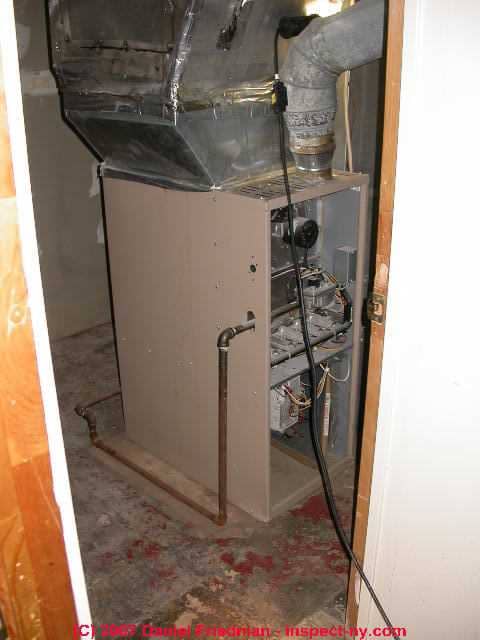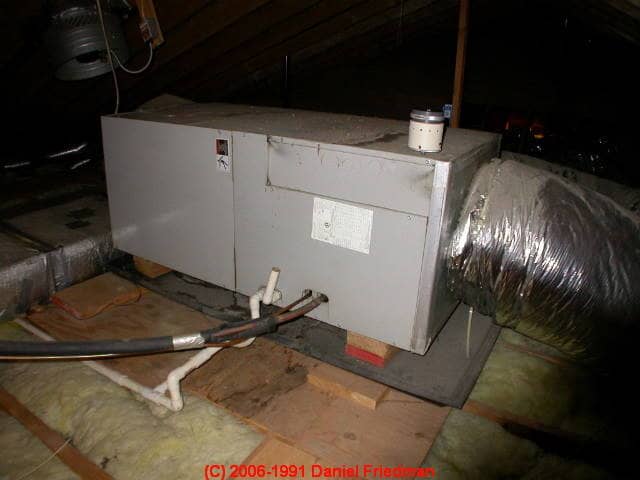 Air Handler Diagnosis & Repair
Air Handler Diagnosis & Repair
Weak or No Air Flow: Blower Fan, Cooling Coil, Air Filter
- POST a QUESTION or COMMENT about how to diagnose & repair problems with the air handler or blower unit / fan assembly in a warm air furnace or air conditioning system
Troubleshoot the indoor air handler or blower unit for A/C or heat pump or furnace system.
Quick troubleshooting guide for air handling units or blower assemblies in air conditioners, heat pumps, some furnaces.
InspectAPedia tolerates no conflicts of interest. We have no relationship with advertisers, products, or services discussed at this website.
- Daniel Friedman, Publisher/Editor/Author - See WHO ARE WE?
Air Handling Unit Troubleshooting - Quick Checks to fix no air flow or weak air flow
Article Contents
- AIR HANDLER BASIC TROUBLESHOOTING CHECKS
- DIRTY blower fans, reduced air output
- LEAKY Air Conditioning air handler unit (AHU)
- MOLDY Growth in Air Conditioning Blower Fans
- DIRTY A/C BLOWERS
This page gives troubleshooting and maintenance procedures for the indoor air handler or blower unit used in air conditioning, heat pump, and forced warm air heat furnace systems.
More-detailed procedures for troubleshooting and repair of the air handler are at our RECOMMENDED ARTICLES list at the bottom of this page.
Basic air handler unit or blower unit troubleshooting checks
Here we provide air handler unit or blower assembly troubleshooting by expanded annotated information from the US EPA [5] who provided suggestions for investigating the air handling unit during an indoor air quality investigation.
- Is the system turned on? Check thermostat to see that it is calling for heat or cooling, service switches at the equipment, check fuses or circuit breakers serving the equipment; for cooling systems check for a condensate drip tray overflow switch that may have turned off the system.
- If your air conditioning or heat pump system has lost its cooling capacity or won't start
see REPAIR GUIDE for AIR CONDITIONERS.
If all of the controls are calling for system operation but the blower motor won't run,
see ELECTRIC MOTOR DIAGNOSTIC GUIDE.
See COOLING CAPACITY, RATED of air conditioning equipment if the system seems to be working but is inadequate to cool your building. - Is air flowing from the air supply registers?
see DUCT SYSTEM DESIGN SIZE & DEFECTS - also check for a clogged or dirty filter or blocked air return.
Initial, simple diagnostic checks of the air handler system are also described
at Ducts & Air Handler diagnosis: Basic checks of the indoor air handler (blower), air ducts, and filter systems. - Is the blower assembly fan operating? You should hear the fan motor running and the fan assembly should be spinning. If the blower fan motor won't run
If the fan won't run at all
See FURNACE FAN WONT START
Also
See BLOWER FAN OPERATION & TESTING
See ELECTRIC MOTOR DIAGNOSTIC GUIDE
If the fan won't stop running
See
FAN WONT STOP - LIMIT SWITCH
FAN WONT STOP - THERMOSTAT SWITCH - Is the blower fan cutting on or off when you think it shouldn't ?
See
CASE 1: the furnace BURNER cycles ON-OFF during a call for heat, BLOWER remains ON - high limit rocking
CASE 2: the furnace BLOWER FAN cycles ON-OFF while BURNER remains ON - blower short-cycling
CASE 3: the furnace BLOWER FAN cycles ON-OFF AFTER a call for heat, BURNER remains OFF - residual heat purge problem
Also see FURNACE FAN STOPS EARLY
- Are the air filters installed, proper size, clean?
See AIR FILTERS for HVAC SYSTEMS - Are the duct dampers working?
Some HVAC systems use manual or automatic duct dampers
or ZONE DAMPER CONTROLS to open or close airflow through individual duct system sections.
Commercial and large building duct systems may include fire dampers that could be closed. - Is the air handler or its condensate drip tray dirty? Are there moisture, debris, visible mold, or other contaminants (rodents, birds) in or around the air handler or blower assembly?
See DIRTY A/C BLOWERS below in this article. - Are the coils dirty or iced or blocked?
Are the evaporator coils (cooling coils or heating coils) clean?
See DIRTY COOLING COIL / EVAPORATOR COIL
and see FROST BUILD-UP on AIR CONDITIONER COILS
see COOLING COIL or EVAPORATOR COIL for a description of diagnosis and repair of cooling coil problems since this component is normally located within the air handler chassis as well.
A cooling coil which is blocked by debris or ice and frost can obstruct air flow and reduce air conditioning system output. - Is the condensate pan clean
and is condensate draining out of the pan and disposed of at a proper and safe location?
See CONDENSATE HANDLING, HVAC - Is the heating combustion equipment venting
properly and does it have adequate combustion air supply?
See CHIMNEY INSPECTION DIAGNOSIS REPAIR
and BACKDRAFTING HEATING EQUIPMENT
Dirty A/C or Heat Pump Blower Units - Dirt-blocked air conditioner air handler fans
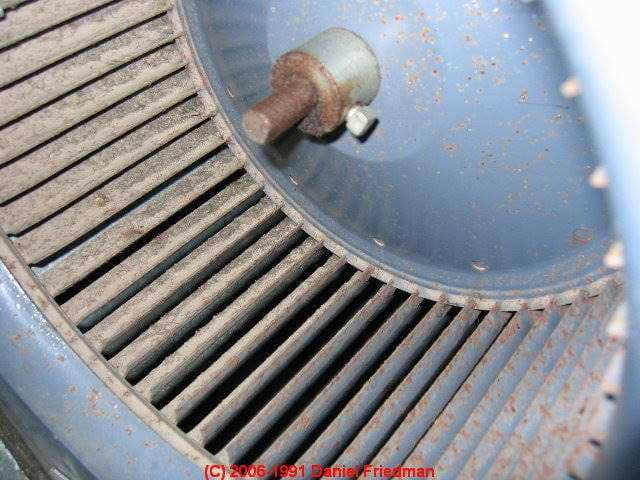
We also discuss how to improve indoor air quality by installing a cascaded air filter system at the air conditioning (or heating system) air handler to provide optimal air particle filtration for people with asthma, allergies, or indoor mold or other IAQ concerns.
Filters protect the blower assembly:
The typical A/C system circulates air through the building duct work using a "squirrel cage" blower fan.
It is very important for you to check and change air filters at least monthly when the system is in use to protect the blower fan from dirt clogging.
Cupped fan blades can become blocked by debris:
The blades of a squirrel-cage fan are cupped in order to cause the spinning cage to move air.
Dirt accumulation on the blades fills-in this cupped area, ultimately changing the "cup" to a simple flat area.
The fan will spin just fine. I've seen the cubic feet per minute of air conditioning air-flow literally double when a very dirty squirrel cage fan fan of this type was cleaned or replaced.
Cleaning an air conditioner squirrel cage fan with compressed air?
If the blower fan blades have significant dirt accumulation, you should have the system professionally cleaned.
While this is a fairly costly service call (requiring blower disassembly and removal for cleaning) it can make a dramatic improvement in system performance.
Do not permit a simple "blow out" of the blower by compressed air if the air handler/blower are in the living area. Some HVAC service companies use a foaming cleaner for removing debris from an evaporator coil. That same material might assist in cleaning a squirrel cage fan.
Otherwise we recommend removing the fan and cleaning it thoroughly outside. Clean the remainder of the fan cabinet and housing before returning the air handler to service.
See BLOWER FAN ASSEMBLY CLEANING - separate article>
Leaks, Dirt, Rodents Getting Into HVAC Blowers, Blower Compartments, Air Plenums
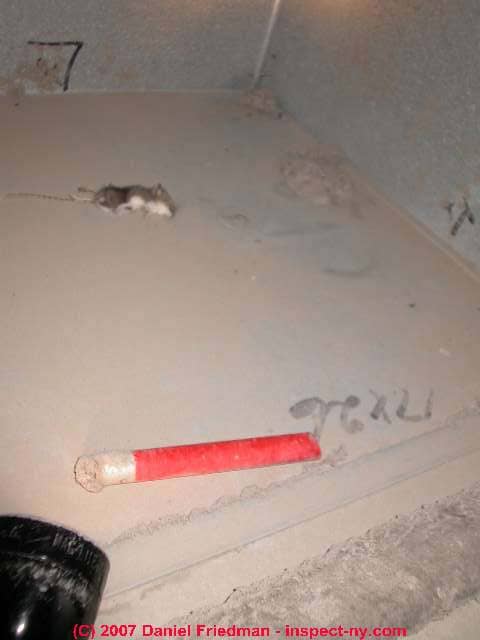
Very dirty, wet, leaked-into, or rodent-infested blower compartments risk indoor air quality and health issues in buildings.
The return air plenum in the photo has both a dead mouse and some other sort of trash that probably fell down a return air floor grille.
Mice in HVAC systems are a potential viral or bacterial hazard as well as an indicator of poor housekeeping.
Leaks into the blower compartment of an HVAC air handler invite mold problems too.
These conditions suggested that there had not been regular inspections of this equipment.
The air handler unit in this photo needs cleaning, disinfection, and a check for unsafe electrical wiring due to leaks.
Causes & Photographs of Mold Growth in Air Conditioning Blower Fans
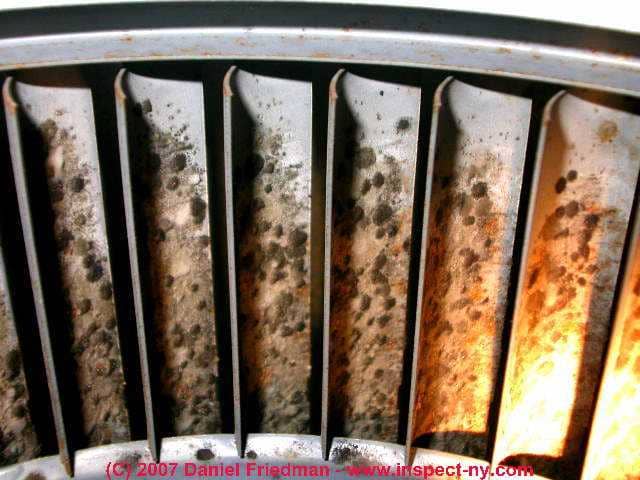
Notice the multiple colors and textures of mold growing on this air conditioner squirrel cage blower fan.
Mold, depending on its genera/species, moisture conditions, and growth substrate material, can grow on many different surfaces where some organic material is available for "food".
We might find mold growing in an air conditioner on plastic, on air cabinet or duct insulation facing, hidden in fiberglass insulation, or on other materials.
Most likely the mold growing on this blower fan found a home in some of the organic constituents of common house dust: skin cells and dust mite fecals.
Very often the mold we sample and identify in air conditioner blower cabinets is a very common genera, Cladosporium sp. - a mold so common it's called "the king of molds."
Kicking up leaves outdoors exposes you to more Cladosporium sp. than the mold on this blower fan.
But we also find some genera/species of more toxic molds that will grow right on top of other molds that are already present.
So while air cabinet conditions may start by producing one mold of not too much concern, other more highly allergenic or even toxic molds could be present.
The fact that the mold in this photograph includes multiple colors and textures of material suggests that more than one genera or species of mold is present.
How to Handle Small Areas of HVAC System Mold Contamination
If the total area of moldy material is small (say less than 30 sq.ft. of contiguous mold) we would not bother to take a mold sample back to our lab for identification. Instead we'd suggest that the moldy surfaces be cleaned or non-cleanable material like insulation, replaced, and the cause for its growth corrected.
We might, however, sample even a small amount of visible mold as part of a larger building diagnostic program if there were illness or air quality complaints associated with the building.
Examples of condensate spill-over inside of an air handler blower compartment, a condition creating a risk of mold growth inside the HVAC system are
at BLOWER LEAKS, RUST & MOLD
See WHY DOES MOLD GROW in INSULATION? for examples of mold growth on the interior surface of fiberglass-lined HVAC ducts.
More information about the potential of toxic mold growth in fiberglass ducts or fiberglass HVAC duct insulation as well as other fiberglass insulation products and more example photographs of that condition are
at FIBERGLASS INSULATION MOLD.
How to Keep the HVAC Blower Assembly Clean
 We noted at DIRTY A/C BLOWERS that a dirty blower fan reduces the blower assembly air flow rate, increasing heating and cooling costs, and sometimes leading to actual system operating failures such
We noted at DIRTY A/C BLOWERS that a dirty blower fan reduces the blower assembly air flow rate, increasing heating and cooling costs, and sometimes leading to actual system operating failures such
as FROST BUILD-UP on AIR CONDITIONER COILS that forms not just frost but solid ice if the air flow rate across even a clean cooling coil is just too slow.
At BLOWER FAN ASSEMBLY CLEANING we describe and illustrate a detailed, thorough cleaning of the blower assembly in an air handler that is used for both heating and air conditioning.
BLOWER OPERATION: For effective operation of this system it is essential that it never be operated without air filters in place.
See AIR FILTERS for HVAC SYSTEMS.
If you permit the filters to become very dirty you may need expensive special cleaning or other repairs.
See BLOWER FAN OPERATION & TESTING.
COOLING MAINTENANCE TIP: The HVAC blower assembly should be serviced every two years. Without proper service the system may have no more than a five year lifetime.
ENERGY CONSERVATION: Keeping the fireplace flue closed (if you have one) when not in use will improve both heating and cooling efficiency in all buildings. or select a topic from the closely-related articles below, or see the
complete ARTICLE INDEX.
Thank you to our readers for their generous comments
Very great information, thanks. - On 2017-07-01 by Kenneth Wood
...
...
Continue reading at BLOWER LEAKS, RUST & MOLD or select a topic from the closely-related articles below, or see the complete ARTICLE INDEX.
Or see AIR HANDLER / BLOWER UNIT FAQs - questions & answers posted originally on this page
Or see REPAIR vs REPLACE AIR HANDLER BLOWER UNIT FAQs - Q&A about deciding to fix versus replace an older or damaged AHU
Or see these
Recommended Articles
- AIR HANDLER / BLOWER UNITS - home
- AIR HANDLER BLOWER DOORS
- AIR FLOW TOO WEAK
- BLOWER FAN ASSEMBLY CLEANING
- BLOWER FAN OPERATION & TESTING
- BLOWER LEAKS, RUST & MOLD
- DIRTY A/C BLOWERS
- DIRTY COOLING COIL / EVAPORATOR COIL
- DIRTY HVAC COIL CLEANING PROCEDURES
- FAN, AIR HANDLER BLOWER UNIT
- FAN LIMIT SWITCH TROUBLESHOOTING
- FAN MOTOR START CAPACITORS
- FAN NOISES, HVAC
- FAN ON AUTO MAN THERMOSTAT SWITCH
- FAN WONT STOP - THERMOSTAT SWITCH
- FROST BUILD-UP on AIR CONDITIONER COILS
- LOST COOLING CAPACITY - if your air conditioner or heat pump stopped working properly
- MANUALS & PARTS GUIDES - HVAC - home
- RETURN AIR, INCREASE
- WET CORRODED DUCT WORK
Suggested citation for this web page
AIR HANDLER / BLOWER UNITS at InspectApedia.com - online encyclopedia of building & environmental inspection, testing, diagnosis, repair, & problem prevention advice.
Or see this
INDEX to RELATED ARTICLES: ARTICLE INDEX to AIR CONDITIONING & HEAT PUMPS
Or use the SEARCH BOX found below to Ask a Question or Search InspectApedia
Ask a Question or Search InspectApedia
Try the search box just below, or if you prefer, post a question or comment in the Comments box below and we will respond promptly.
Search the InspectApedia website
Comments & Questions are Welcome Here
If you posted comments here and no longer see what you wrote, please check for your comment in the Reader Q&A found above on this page.
Citations & References
In addition to any citations in the article above, a full list is available on request.
- Thanks to Mark Cramer, Tampa Florida, for assistance in technical review. Mr. Cramer, a past president of ASHI, is a Florida home inspector and home inspection educator.
- [5] US EPA - Mold Remediation in Schools and Commercial Building [ copy on file as /sickhouse/EPA_Mold_Remediation_in_Schools.pdf ] - US EPA
- Modern Refrigeration and Air Conditioning, A. D. Althouse, C.H. Turnquist, A. Bracciano, Goodheart-Willcox Co., 1982
- In addition to citations & references found in this article, see the research citations given at the end of the related articles found at our suggested
CONTINUE READING or RECOMMENDED ARTICLES.
- Carson, Dunlop & Associates Ltd., 120 Carlton Street Suite 407, Toronto ON M5A 4K2. Tel: (416) 964-9415 1-800-268-7070 Email: info@carsondunlop.com. Alan Carson is a past president of ASHI, the American Society of Home Inspectors.
Thanks to Alan Carson and Bob Dunlop, for permission for InspectAPedia to use text excerpts from The HOME REFERENCE BOOK - the Encyclopedia of Homes and to use illustrations from The ILLUSTRATED HOME .
Carson Dunlop Associates provides extensive home inspection education and report writing material. In gratitude we provide links to tsome Carson Dunlop Associates products and services.


